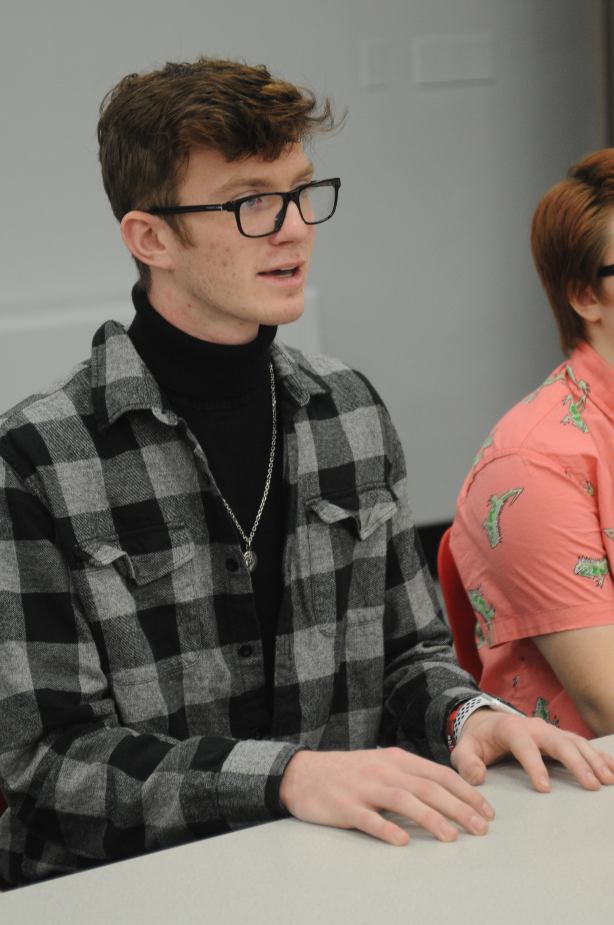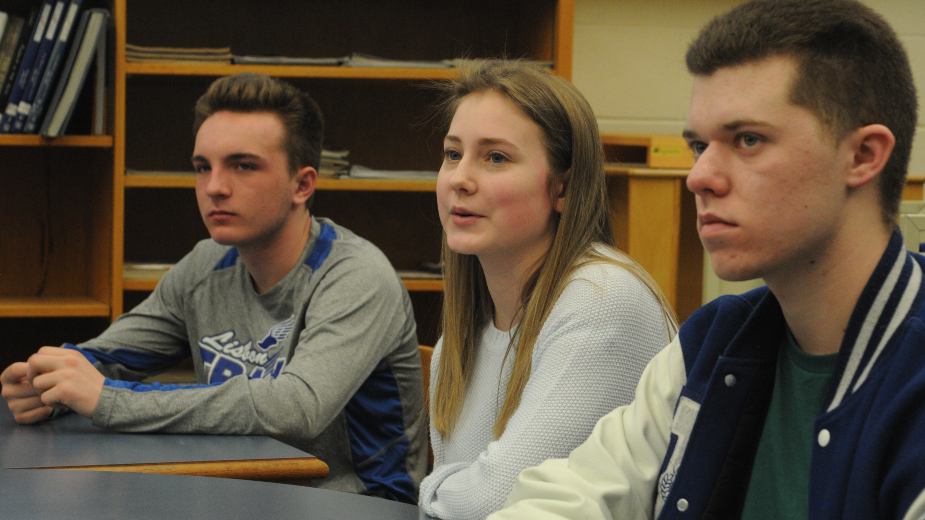YOUNGSTOWN, Ohio — In four years of high school, students are expected to develop some idea of what comes after graduation, whether it’s enrolling in college or a trade school, enlisting in the military or joining the workforce.
Panel discussions with area high school students last month found most students interviewed plan to attend college. The panels were conducted with students from Salem High School, David Anderson Junior/Senior High School in Lisbon and Chaney High School in Youngstown as part of The Business Journal’s Brain Gain program.
Most of the students indicated they are prepared for college coursework but not for the high cost of college.
“Salem has done a pretty good job of preparing me for what I need to attend college and how classes are going to be,” says Alex McFarland, junior. McFarland plans to study business in college and aspires to own a property investment company
Ja’Kiyah Rushton, Chaney High School, plans to major in psychology at Ohio State University and is getting a head start through its Young Scholars program with Youngstown City Schools.
“It’s pretty good and I could get scholarships from both programs if I follow through with it,” she says. One-on-one tutoring has helped Rushton understand challenging course material, she says, and the teachers at Chaney are accessible.
Financing post-secondary education is a concern for many of the students, though some seemed resigned to the fact that they will need to accrue debt to achieve their goals.
While college tuition varies, the average annual tuition costs for a public four-year in-state college is $9,970, while the out-of-state yearly rate is $25,620. The average cost of a private college is $34,740, according to StudentDebtRelief.net.

“I think everybody should be concerned about it [cost of college] because it’s such a big thing these days. You go to college for four years and you’re in debt for the rest of your life,” says McFarland, whose mother has been saving for his college education since he was young.
Some of the students interviewed work part-time jobs to save for school or plan to rely on academic and athletic scholarships to help cover the cost.
Maddy Workman, sophomore at Salem, says two of her older sisters dropped out of college after one year and one of them is still paying off the debt from that year.
Workman plays softball and volleyball and runs track, and hopes she can earn athletic scholarships to help pay her way to study medicine.
“I guess I’m just relying on athletic scholarships and academic scholarships to get me most of the way there and try and figure out the rest,” she says.
Laura Waters, a senior at Lisbon, says she’ll likely attend Kent State University at Salem to study insurance because it’s easier to commute and is less expensive than living on campus. The cost of college is a big factor for her, so she plans to live at home.
“I don’t want to be paying them back forever. But if that’s what I have to do, then I’ll do it,” Waters says.
Some of the students are basing their majors and career choices on the cost of college.
Doug Stiffler, a senior at Salem, plans to work at a machine shop until he’s 21 and then enroll in the police academy, forgoing college altogether.
Cassie Brandt, a senior at Lisbon, plans to study dental hygiene at Youngstown State University. Although she’s interested in a career in medicine, she doesn’t want to attend college for longer than four years because of the cost, she says.
“I just wanted to do something that I can definitely stay local and have a job, and also go anywhere and I would still be able to have a job,” Brandt says.
Though students agree they are academically ready for the next step, the cultural transition makes some of them nervous. For the college-bound students, the idea of leaving their families to live on a campus is intimidating.
College visits help acclimate students to the size of a campus and take the edge off the potential culture shock. Brianna Steele, a junior at Lisbon, toured Youngstown State University on Valentine’s Day. She’s used to the size of Kent State Salem where her sister attended, but “YSU is a lot different,” she says.
“It’s a really big campus,” Steele says. “It’s kind of intimidating how big the campus is.”
Steele wants to study premed at YSU with a focus on biology and aspires to be a pediatrician, she says. She’s planning another visit to YSU to explore science programs and talk to some of the professors.
For Nakaia McRae, the Upward Bound program at YSU has equipped her for the transition, she says. Since her freshman year, the senior at Chaney has taken part in the six-week summer program that has her living in the dorms and taking college courses from a professor.
Upward Bound students must maintain good grades and show they intend to enroll in college after high school. During their senior year, students must apply to at least three colleges and take part in monthly ACT and SAT prep classes, McRae says. It’s also given her college credits.
“I would say I have maybe six college credits already with Upward Bound,” McRae says. She plans to attend Central State University in Wilberforce to study prelaw and aspires to be a defense attorney.
Upward Bound serves 50 students annually from Chaney and East high schools, says Kenneth Pugh, director and grant manager. Since most students from those communities have the potential to be first generation college students, the experience teaches them “how to thrive in a college environment that may seem foreign to them.
“They don’t have the added benefit of speaking to someone who has already gone through the experience of college and applied for college,” Pugh says. “We provide that social and cultural experience.”
McRae is also a member of Inspiring Minds Youngstown, which takes under-served students on college visits they would otherwise not experience. This can be critical, as universities are putting greater weight on the applicant demonstrating an interest in the college.
According to the National Association for College Admission Counseling, demonstrating an interest in a college can affect a student’s chances for admission.
Last year, Inspiring Minds Youngstown took five students on college tours in Philadelphia as well as to YSU, says its executive director, Stephanie Gilchrist. Students met with admissions staff to discuss the benefits of going to college, the impact a grade point average has on scholarship opportunities, the importance of ACT and SAT scores and finances.
“They were able to open their eyes to a whole new world outside of high school,” Gilchrist says.
Whether bound for college or the trades, Inspiring Minds works to identify students’ interests and help them achieve their goals, Gilchrist says. Two of its seniors are interested in physical therapy, and the organization is working with Mahoning Valley College Access Program to coordinate a visit to a trade school for them, she says.
“We have to find that niche for them, that passion for them. Then we have to cater to that desire that they have, and it’s not always going to be college,” she says.
Ke’Lynn Dean, a senior at Chaney, plans to study education at YSU and teach in Youngstown City Schools. As a mentor for younger students at Inspiring Minds and as a counselor at Camp Fitch, Dean works to establish a connection with the kids now “so that when I do join the workforce, there won’t be that much of a disconnect,” he says.
In addition to assisting Dean with college prep and scholarship application, Inspiring Minds helps with networking in the community and getting in touch with people who can help get him where he needs to be professionally. Dean already has acceptance letters to colleges he’s applied to, he says.
Mentors at Inspiring Minds stress the importance of going to college, which isn’t common in his community, Dean says.
“There’s not a lot of motivation. It’s not really a big thing, going to college and pursuing a career after high school,” says Dean, adding that more students are pushed toward the trades.
A reason is that so many of them are first-generation college students, Gilchrist explains. Along with concern over financing, students, as well as their parents or guardians, can become discouraged by the application process, she says. Thus, it can be easier to encourage students to go to trade schools instead.
“To complete the tasks that are necessary to get into a four-year college program, it becomes complicated and difficult,” she says. “The application is intimidating. They get scared and they’re nervous.”
Conversely, the trades aren’t being pushed hard enough to students in Lisbon, contends Zane Tullis, a junior at David Anderson. During the panel discussion, Tullis was one of two Lisbon students considering the trades. He attends the Columbiana County Career & Technical Center and, after serving in the Air Force, wants to study technical aircraft maintenance at the Pittsburgh Institute of Aeronautics so he can eventually work on commercial aircraft.
Studying at the career center has given Tullis the confidence he needs for his next step, he says.
“I don’t think that high schools do a good enough job pushing trades and military,” Tullis says. “In a week or so, I’m taking the ACT. It’s all I’ve heard about since I was a freshman: ACT, ACT, ACT, ACT. I took the ASVAB and it practically changed my life.”
The ASVAB, or Armed Services Vocational Aptitude Battery, is the entrance exam for the military. It measures a student’s general knowledge to determine his aptitude for various military occupations.
“Even if you don’t want to go into the military, I think the ASVAB is just as important, if not more important, than the ACT because it will really open your eyes to what you’re good at versus what you’re interested in,” he says. “Honestly, in this area, there’s a lot of great opportunities with the trades.”
While schools push college visits and job shadowing opportunities, sophomores are taken to the career center once to see what’s available, Tullis says.
He suggests bringing more trades workers into the schools to talk to the students about what they do and what sort of training and career opportunities and apprenticeships are available.
From school announcements in Salem, Michael Kidd learned of a firefighter internship program through the Mahoning County Career and Technical Center. A Federal Emergency Management Administration grant paid for the classes he started taking as a freshman. Now a senior, he works as a volunteer firefighter and will move to full time next year after he earns his EMS first responder certificate, he says.
“Most career firefighters are in their mid- to late 20s, early 30s,” he says. “I’m the youngest at my station by I think five or six years, but I’m doing the same thing everybody else can do.”
Pictured above: Zane Tullis, Cassie Brandt and Trenton Kliner share their thoughts about what comes after high school.
